What you’re about to read is indeed taking a team of players that multiple teams of builders have dedicated their life in that moment to building…and I’m going to offer a hypothetical completion of that build for the 2023-24 NHL season.
If you care to know more about me, you can read my profile by clicking my byline. For now, let’s get to the fun and see what kind of Pittsburgh Penguins team could be built this offseason.
As they have given us the sandbox to play in, a tip of the cap to CapFriendly, whose graphics you will find throughout this piece. According to CapFriendly, Pittsburgh currently has 16 players signed and a current projected cap of $68,291,842, which gives us $15,208,158 in cap space to start with.
Start with being the operative phrase, as we’ve got some space to open that will create more options. Opening that space will cost assets, and this is where I’d like to thank Ron Hextall for making several mind-numbing moves during his stewardship of the team that will make my work here (not to mention real-life President of Hockey Ops Kyle Dubas’s job this summer) that much more difficult.
Pittsburgh has the following (obvious) needs:
- Starting goalie
- Top-four defensive defenseman
- Entirely revamped bottom-six forwards
That’s a lot, and $15 million may not be enough to accomplish this. This means we’re going to start by freeing up cap space, as you can never have enough.
As we have now completed the NHL Entry Draft and are nearing the end of the first of two buyout periods, this one lasting until Friday, June 30th at 5 pm, this is when mind-boggling cap dump trades and buyouts can happen.
The Albatrosses
In Pittsburgh, Dubas has two true albatross contracts on his roster:
Mikael Granlund, 31, two years, $5 million per
Jeff Carter, 38, one year, $3.125 million, 35+, NMC
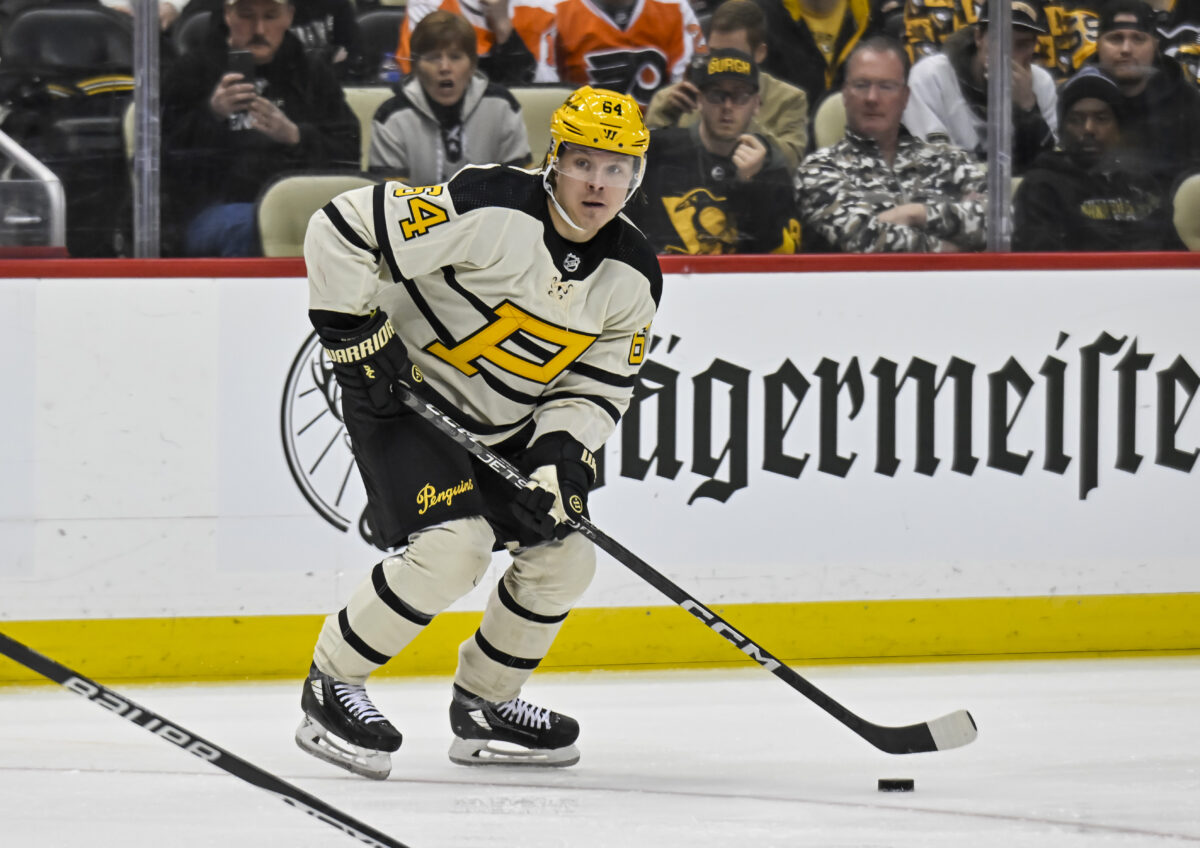
The Carter situation is simple: his offensive skill disappeared last year, as did his skating ability. His defensive game, never his go-to, fell off a cliff. At 37, athletes who’ve played close to 20 years of pro hockey and all the physicality, travel, and overall lifestyle that entails (on top of having played hockey virtually their entire lives) do not increase their athleticism or speed. His no-move clause will make him difficult to trade to the type of team willing to take on his contract (Arizona, San Jose, Chicago). As it’s a 35+ contract, buying him out simply takes him off the team while keeping his full cap hit on your cap. In short, there are few options. Ideally, Carter is not on the team next year.
Granlund is more interesting. If you’ve followed Toronto these past few years, you’ll be familiar with Dubas’s longstanding interest in Granlund and that Dubas reportedly repeatedly looked into acquiring him in recent years. As a result, there is absolutely a world where Dubas looks at his team’s need for another top-six winger to replace Jason Zucker, talks himself into Granlund still being young at 31 and capable of being a solid passenger on a line centered by either Sidney Crosby or Evgeni Malkin, and keeps Granlund.
Thankfully for us, this is not that world. Granlund must go.
The threshold to have to give up a first-round draft pick to trade a bad contract is around $6 million. At $5 million, Granlund should cost the Pens a second-round pick to trade, which we’ve seen this week in the Josh Bailey trade. So, this is where we start:

Not having a no-trade/move clause, Granlund can get dealt anywhere. The Arizona Coyotes, in a perpetual state of rebuilding and having to add nearly $6.5 million this summer, simply to hit the cap floor, should have interest in a trade like this. That fact the pick is in 2026 helps the Coyotes, who are flush with picks in this and the next draft, with fewer (extra) picks in 2026. If Granlund plays well, they can flip him for another asset, thereby utilizing their cap space and a declining asset to acquire two assets. If not, they got a second-round pick and filled some cap space. It’s an easy win for Arizona, and it erases a huge mistake that Hextall made only a few months ago.
To bury the Carter conversation, while he may get dealt (cost should be a third-round pick), we’re not doing that here as we have bigger goals in mind and limited draft capital. On this team, Carter is the 13th forward, and the Penguins hope he can find some magic for the playoffs next year (where the cap doesn’t exist).
Now that we’ve opened some cap space, let’s have some fun.
The RFA Signing
Last week, Edmonton Oilers general manager (GM) Ken Holland said he’s in no rush to sign top young defenceman Evan Bouchard and gave the impression that he’s looking to do a 1-year deal to keep the cap hit low. This week, Holland made clear that he can only sign Bouchard to a bridge deal. This scenario makes Bouchard the perfect target for an offer sheet.
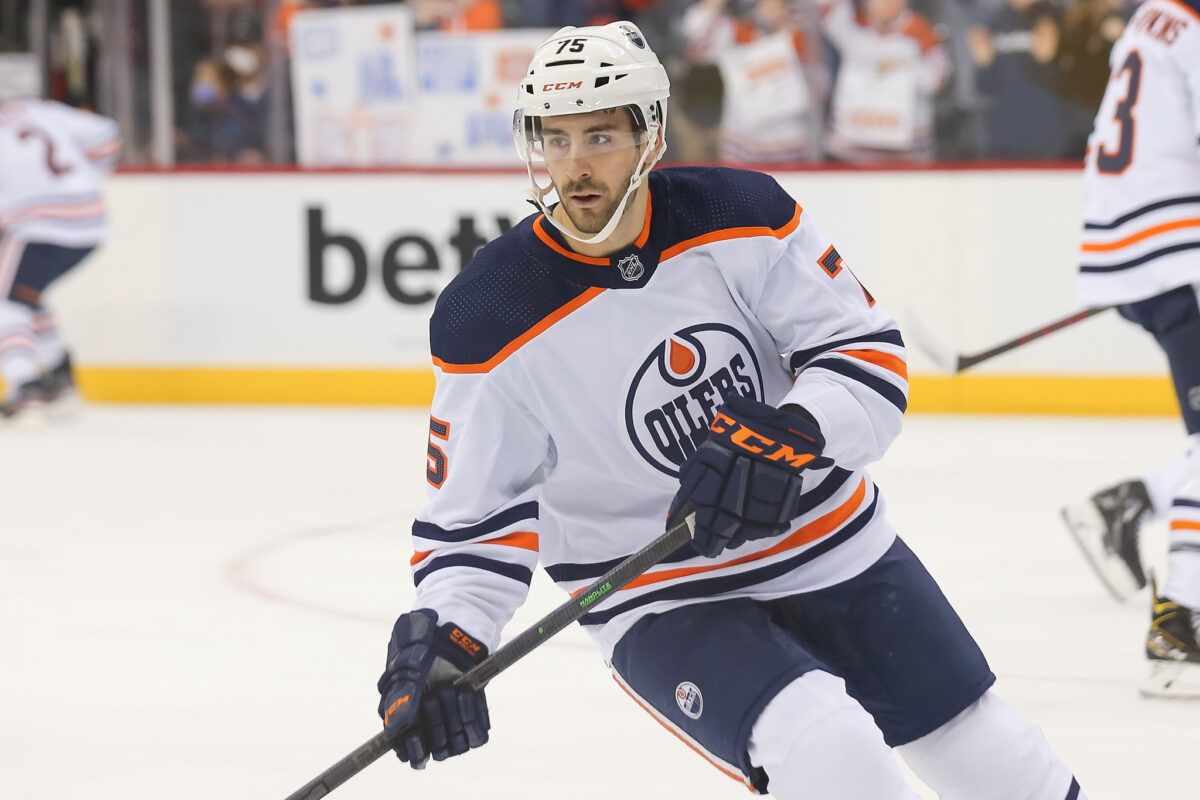
Edmonton currently has 17 players signed and only $8.170 million in cap space to fill out their roster.
With back-to-back 40-point seasons in his first two full seasons in Edmonton, along with a shocking 17 points in 12 playoff games, Bouchard today is likely worth $6 million, and based on both current D salaries and the impending (knock on wood) salary cap increase in a year, one could see him peaking at over $9 million in a few years. So, what do the Penguins offer?
If we go to $6 million, Bouchard has some reason to take it, though Edmonton could match by trading Warren Foegele, trading one or both of Cody Ceci and Brett Kulak and filling out the team with entry-level players. It is similar to when Montreal made their restricted free agent (RFA) offer to Sebastian Aho a few years back that everyone in hockey knew would be matched, and it was.
To get a player to both sign an RFA offer sheet and have a chance to successfully acquire him, you have to be aggressive with your offer. A six-year, $45 million offer is that aggressiveness.
For Pittsburgh, this is $7.5 million x six years for a top offensive defenseman who can play 2nd pair minutes with the right defensive partner or dominate 1st pair minutes with a top defensive partner. If you view it as:
Year 1: $6 million
Year 2: $6 million
Year 3: $7.5 million
Year 4: $7.5 million
Year 5: $9 million
Year 6: $9 million
The value relative to the salary cap in those years becomes clear. This is first pair money right now, which means it will be a deal for Pittsburgh throughout the contract. If you think it’s not enough money, then you’ve over-rating Bouchard based on The Ekholm Effect. If you think it’s too much money, the breakdown illustrates the perceived value throughout the contract based on his age and projected performance at that age.
If it’s a deal for the Pens, why sign if you’re Bouchard? Why not do what Vladislav Gavrikov did and only sign short-term to cash in later? It’s simple. As 2020 taught us, there are no guarantees, especially when it comes to money (have you seen the mortgage rates lately?!). This is multi-generational, life-changing money. Regardless of any hypothetical cap, it would be tough to turn down, and not a lot of agents will be telling their clients to overlook one lottery ticket in the hopes of an even bigger one. Also, this contract would end when Bouchard is 29, which gives him the chance to cash in yet again. The structure of this first deal would give him a legit chance to earn $100 million US throughout his career. Again, most people are absolutely going to take the path which leads them to that kind of money.
If you’re Pittsburgh, why do this, especially when you have Kris Letang under contract for several more years? The answer? Health, Letang has suffered two strokes in less than a decade and is not guaranteed to last the duration of his contract, which ends when he is 41. Therefore, no one should expect his play at either end to stay at its current level for the next five seasons. However, he would be a tremendous mentor to Bouchard.
The cost of this is not prohibitive:

Two mid-to-late round firsts, a second, and a third? For where those firsts would land, Bouchard is far more likely to have more value, especially as Pittsburgh is a win-now team. This is a no-brainer! Let me go and make sure that I have those picks…
Checks the Big Board of Draft Picks…
Throws computer across the room.
Damn you Hextall.
Hexy wasn’t into RFAs, because as the RFA period starts after the draft, you must have your team’s picks available as compensation. A GM, either paying attention or willing to entertain the idea of an RFA offer, would consider this when making trades.
To be clear, it cannot be another team’s picks, even if theirs is a better pick in that round than your own. Pittsburgh is only missing their third-round pick in 2024, which is currently sitting with Anaheim as part of the Dimitry Kulikov trade.
Well, this is going to cost something extra…

Not a lot though, this isn’t the kind of trade where the other team would hold you up for anything tangible.
So now, we can make the offer to Bouchard. For Edmonton to match, it would take their salary cap to $82,130,000. Yes, that is currently under the cap, and yes, teams can go over the cap by 10% in the offseason. To match it though, they would have to make all the aforementioned moves and somehow erase Jack Campbell’s salary. Can they? Certainly, only through a buyout though, as the remaining four-year term is prohibitive. A buyout would save Edmonton nearly $3.5 million this year, nearly $3.9 million next year, down to approximately $2.6 million and $2.3 million in the last two years of his contract, and then leave a $1.5 million dead cap money hit from 2027-28 through 2030-31.
Removing half of Edmonton’s right wing corps, two of their top-five D (all through trade), and a goalie who had a very challenging first regular season yet put up good numbers in limited (cleanup) playoff time (via buyout), leaves Edmonton with 13 skaters, one goalie signed, and a salary cap of $74 million. They would need to sign either a 1A or 1B goalie, a top-six and a top-nine RW, a top-four and a third-pair defenceman, and re-sign Ryan McLeod ($2.5-3 million). You’re nearly $15-20 million in here, plus future dead cap space. Edmonton would have to decline matching, take the compensation, and would of course use it to trade for assets to fill their holes.
Through the RFA system, Pittsburgh can and should sign Bouchard.
What else should the Pens do this offseason?
Trades

Florida will have both the LTIR cap space and the need, as both Aaron Ekblad and Brandon Montour will start the year injured, and Radko Gudas is an unrestricted free agent (UFA) who will get a lot of attention come Saturday. Rutta is a Stanley Cup-winning defenceman (do not discount the value hockey ops puts on Cup wins) who can play a top-six role and bring some calm to a beaten-up Florida D.

Barring Edmonton working out a trade with Pittsburgh for Bouchard, which would most likely include Ty Smith as he is now a luxury with Bouchard in the fold, Smith would end up on the trade block. This trade works for both teams, as Smith is inexpensive as an RFA who spent almost the entire year in the American Hockey League (AHL) and can play third-pair minutes at a lower cost than this past year’s blue line, and Frederic has earned a raise, one that Boston may decide it cannot afford as they’re in a similar cap spot as Edmonton. If the rumours about Boston wanting to move Hampus Lindholm are true, this gives Boston additional flexibility to make that trade.

DeMelo is a good-to-great defensive defenseman, who in the past has been traded for a third-round draft pick. Ruhwedel, who like DeMelo, only has one year left on his contract, is a sixth to seventh defenceman who had a good year in 2021-22. However, like many other Pens, he did not have a good 2022-23. He is a capable defenseman, who in a good year would be a poor man’s version of DeMelo. Beliveau is seen as a decent prospect, which, when you add to the third-round pick here, brings the total value of this package up to likely be enough to land DeMelo should Winnipeg know that DeMelo likely won’t re-sign and be open to the idea.
And finally, on the trade front…

Barring a miracle of some sort, Detroit will not win the Stanley Cup in the next two years. Two years is exactly how much time is left on Jeff Petry’s contract.
This week there have been talks of many NHLers who are available for free as long as the acquiring team is willing to take on their cap hit. Petry should be one of these players.
Once you wade through the angsty writing of some Pittsburgh columnists, you’ll see that Petry, who had 31 points in 61 games last year, can still play. He would make Detroit’s current blue line better and would be able to play the mentor role to Detroit’s litany of top young defensive players and prospects. As such, despite his $6.25 million contract, the fact that he can still play 20 minutes a night and play on the power play should be enough that you don’t have to attach a high draft pick to the trade. What I have done is add Lukas Svejkovsky to the deal. He is not a top prospect, though he has produced at very high levels in Canadian Major Junior hockey. In other words, he’s a flier, a low-risk lottery ticket for the Pens to trade. He’ll either make it in the top six or not play at all.
Next up, free agent signings. Let’s start with the in-house work.
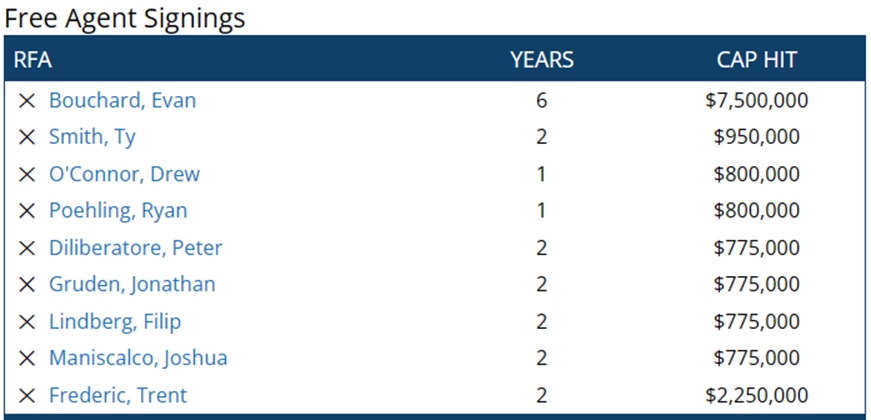
Beyond Bouchard, Frederic, and Smith, there is not a lot to look at here. Poehling and O’Connor are current fourth-liners who will did not do enough last year to garner any large raise. The rest are for minimum salaries. You may ask why a player and their agent would accept a minimum salary. This is a very nuanced question. The short answer is that first, the lower the salary, the better their chances of fitting under the cap as a callup. Second, if they’re likely to spend most or all year in the AHL, they’re either not old enough to be making more than $70,000-80,000 on an AHL deal, or they can leverage overseas opportunities to make low-to-mid six figures in the AHL.
This Pittsburgh team still needs a starting goalie (!), a top-six winger, and to fill out their bottom-six forwards. Here’s who I would target if I were them:

(Note that there are no signings over four years in length. Whenever possible, teams are not trying to tie themselves down with older players.)
Joonas Korpisalo has always had the talent, though, he has had a very inconsistent career. We all know that it’s not the 80s and 90s and that in today’s game, goalies are voodoo. That said, I firmly believe that Korpisalo has rounded the consistency corner, and with what he did in Columbus last year, imagine if he was on a good team that loved puck possession.
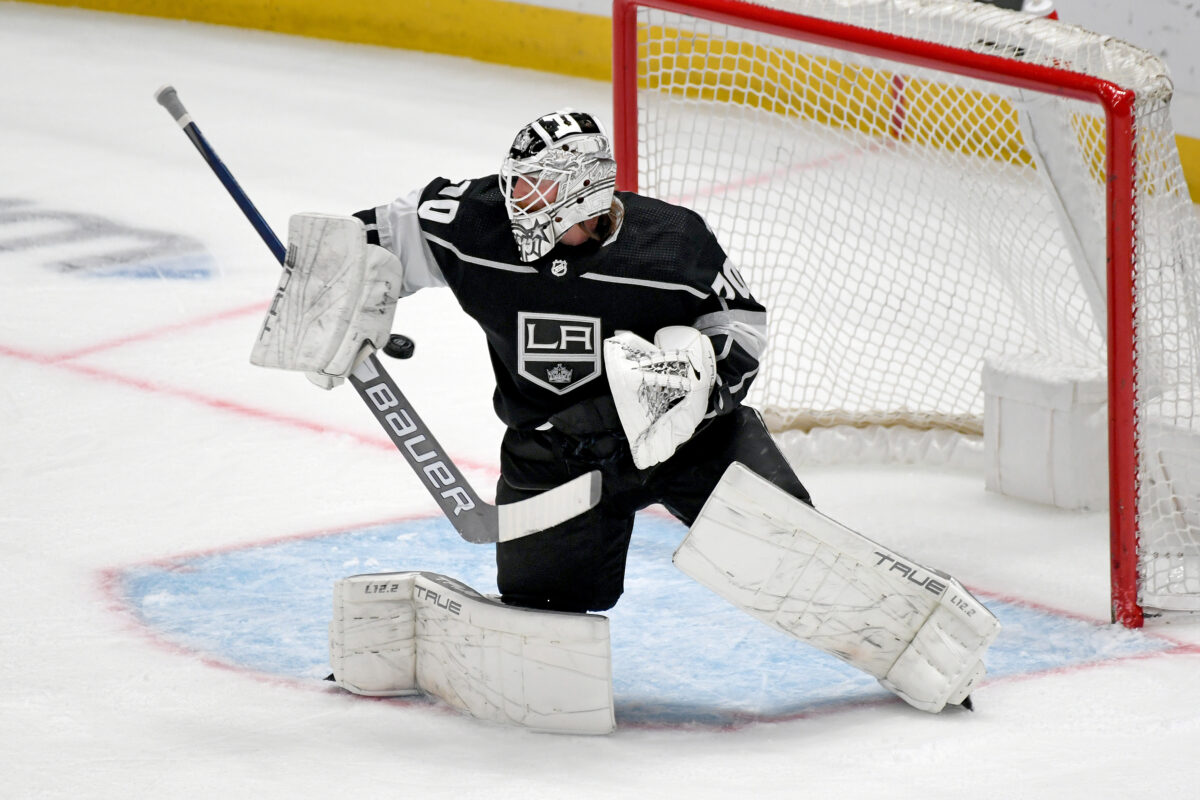
Noel Acciari and Garnet Hathaway are the types of players you need in your bottom six to win it all. They can grind, they hit everything that moves (Hathaway was eighth in the NHL, and Acciari 10, in hits, respectively, with over 500 hits combined), and they can score in the tough areas in front of the net. They are all heart, and those are the types of players that anchor the bottom six of Cup-winning teams.
Carson Soucy is an interesting case. He had a solid year last year, playing just over 40% of his time against elites (1st lines). He’s in line for a raise. He’s also that big (6-foot-5, 208 lbs.) Defencemen that teams will be falling over themselves to get after Vegas’ oversized D-corps won this year. Would he be my first choice? No. Are there a lot of top-four shutdown UFA left defenceman options? No. Has he proven that he can play well enough and stay above water against elites, and for slightly less money would he be an improvement on the outgoing Brian Dumoulin? Yes, and yes.
Nick Bjudstad brought his career back from the Arizona brink this past season. He played so well that during the playoffs, he ended up having some second-line duty on the offensive juggernaut that was Edmonton. He brings a true 200-foot game to the bottom six, where he can chip in on offense and drive defense. He can also step up to the top six as needed. second line power play, first or second penalty kill, he can do a little of everything. It’s also less than someone like David Kampf ($2.4 million x 4 years) just signed for.
This brings us to the lottery ticket. Jonathan Drouin, 28, drafted third overall by Tampa Bay in the 2013 Entry Draft. A pure skill player with two 53-point seasons in his career, he has had consistency issues, and his off-ice issues have likely been cause & effect with his on-ice inconsistencies.
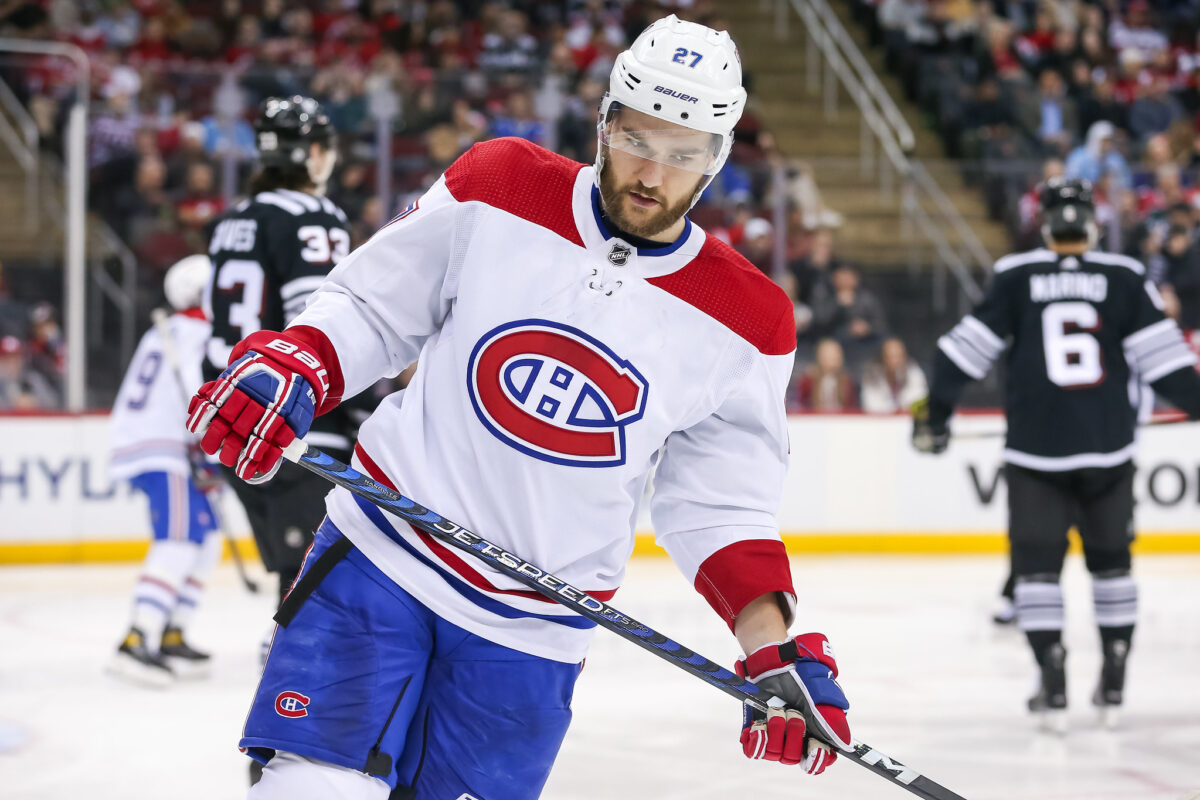
Technically, at 28 years old, Drouin should still be in his prime. The offensive skill/depth he would bring to the Pens would have a very positive trickle-down effect on the left-wing depth chart. If his mind is right and he is in shape, a motivated Drouin could do damage playing with Sid or Geno. Be it on a player tryout in camp or signed to a 1-year deal at the minimum, Drouin is a flier worth taking.
The Team
Now that we’ve built the team, let’s see what it looks like:

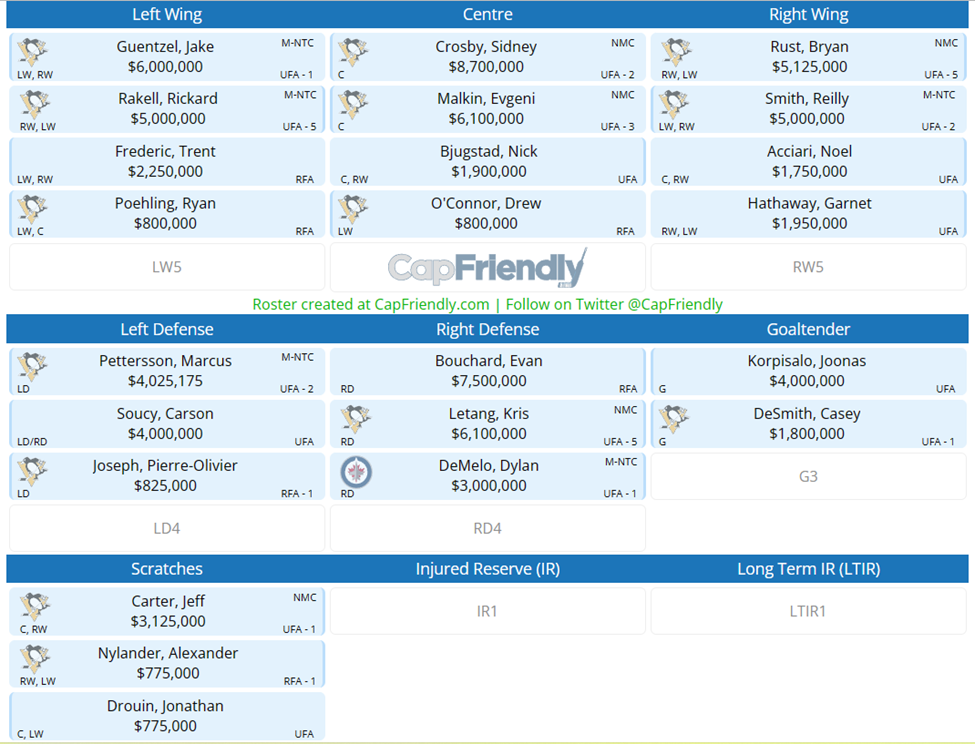
Note the cap space. With nearly $1.3 million in cap space and no one on LTIR, you can accumulate enough extra cap space to trade for a top-six forward or a top-four D come trade deadline time.
The top-six forwards have more defense to go with all their offense. You hope for a bounce-back year from Bryan Rust and that Rickard Rakell simply keeps doing what he does. The Reilly Smith trade was interesting. Personally, I would have signed J.T. Compher to a $5 million x five-year deal, put him at 2C, and moved Malkin to the wing. This would have lessened both the defensive responsibilities on Malkin, as well as saved him literal miles of skating throughout the year, keeping him fresh for the post-season. A stronger two-way second line and a fresher Malkin helps toward the ultimate goal.
The bottom-six is a dramatic change from last year’s. That third line is genuinely tough to play against and can score. The fourth line…it’s not perfect. Improvement from DOC & Poehling, neither of whom have hit their ceiling would make it a far better line, and the one-year deals are dangled carrots to that end. If that does not happen, fourth-line pieces are far from impossible to trade for at the deadline, or even during the season with this cap space. Any consistency from the younger Nylander would be a considerable bonus.
While he’s buried on the third pair, DeMelo would pair with either Petterson or Soucy in any shutdown situation, especially in the playoffs. If POJ takes another step forward and can keep his consistency all season, he could pair with Letang in the playoffs.
Is this team perfect? Far from it. Like everything that was put into it from previous builds and builders, it’s a start and a strong reset on last year. This should set them up for a good regular season, and let the Pens add anywhere in their lineup at the trade deadline.
Dubas, you’re up!
A former professional athlete with 6 years of Canadian Jr. hockey scouting experience, Mike Cranwell brings a view from both the playing field and the boardrooms. Currently working in the corporate world in recruiting/headhunting and contract negotiations, Mike’s well-rounded perspective shapes the teams you will see built here.
